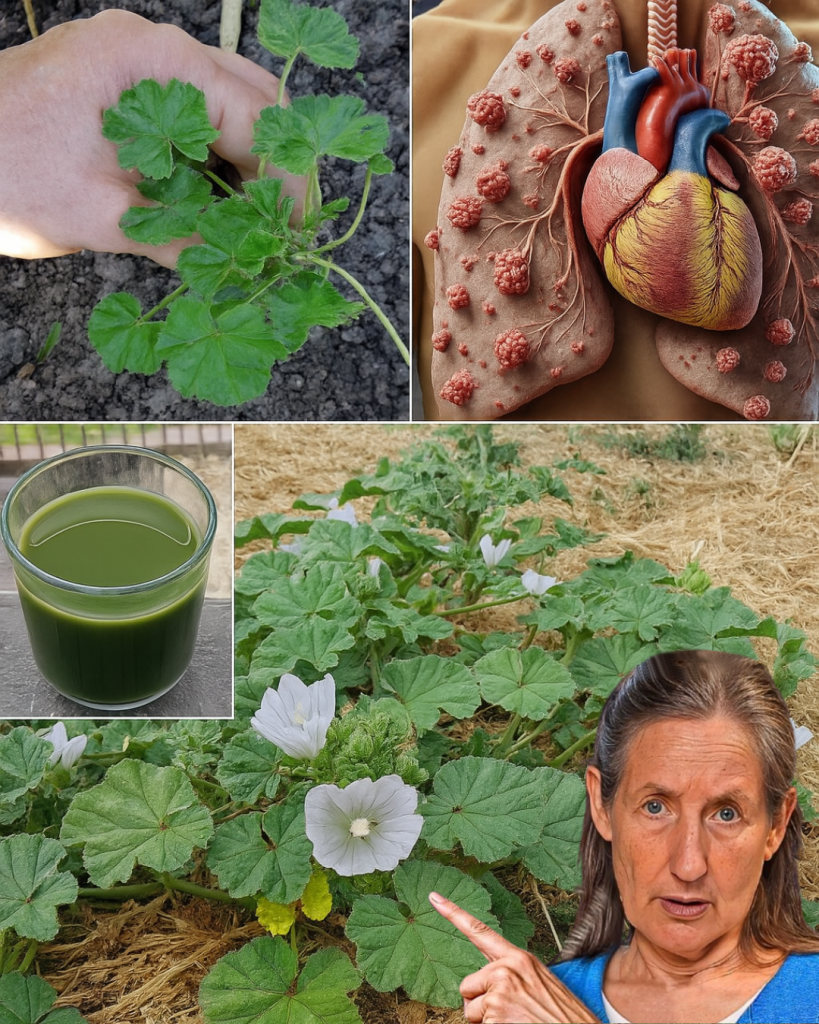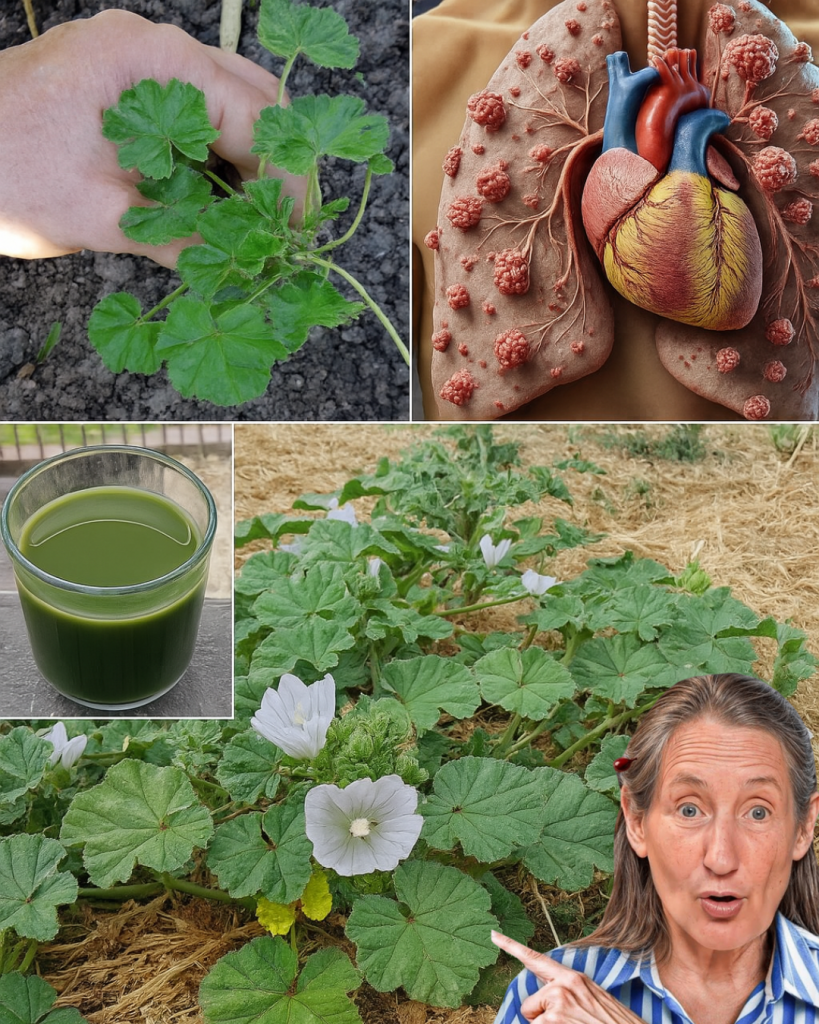What if a plant dismissed as a backyard weed held the key to vibrant health? Meet Malva sylvestris, or common mallow, a humble herb that’s been quietly stealing the spotlight in herbal medicine for centuries. With its delicate purple flowers and lush green leaves, this unassuming plant is a nutritional powerhouse packed with vitamins, minerals, and healing properties. From soothing your digestive system to nourishing your skin, common mallow is a versatile ally that deserves a place in your wellness routine. Ready to discover why this overlooked gem is anything but ordinary? Let’s dive into the captivating world of common mallow and explore its transformative benefits.

🌸 A Plant with Ancient Roots
Common mallow is no stranger to the world of healing. Native to Europe, North Africa, and Asia, this herbaceous perennial has been cherished since ancient times for its medicinal and culinary uses. Its heart-shaped leaves and vibrant blooms dot meadows and gardens, thriving in temperate climates with ease. While often mistaken for a weed, mallow’s rich history—from ancient Greek remedies to medieval herbal tonics—reveals its true value. Today, it’s celebrated by herbalists and health enthusiasts for its ability to nourish, heal, and soothe, making it a must-know for anyone seeking nature’s finest remedies.
🥗 A Nutritional Treasure Trove
Common mallow is a nutritional dynamo, brimming with essential nutrients that fuel your body. Its leaves and flowers are loaded with vitamins A, C, and K, which support vision, immunity, and blood clotting. It’s also rich in minerals like calcium for strong bones, magnesium for nerve function, and potassium for heart health. But that’s not all—mallow’s flavonoids and phenolic acids deliver powerful antioxidant effects, fighting free radicals and reducing the risk of chronic diseases. This plant isn’t just food for the body; it’s nourishment for a vibrant life.
💊 5 Remarkable Health Benefits
Common mallow’s healing powers are as diverse as they are potent. Here are five science-backed and time-honored benefits that make this plant a wellness superstar.
🍵 Soothes Digestive Discomfort: Struggling with indigestion or bloating? Mallow’s mucilaginous properties, found in its leaves and roots, create a soothing gel-like coating in the digestive tract. This calms irritation, eases stomach upset, and supports healthy digestion, making it a natural remedy for gastrointestinal woes.
🛡️ Fights Inflammation and Oxidative Stress: Packed with flavonoids and phenolic acids, mallow is a potent anti-inflammatory and antioxidant. These compounds reduce bodily inflammation and neutralize free radicals, offering protection against conditions like arthritis and heart disease.
🫁 Supports Respiratory Health: Coughs or congestion holding you back? Mallow’s expectorant properties loosen mucus in the airways, making it easier to breathe. Traditionally used in teas or syrups, it’s a go-to for soothing sore throats and clearing respiratory discomfort.
🧴 Nourishes and Soothes Skin: Mallow’s emollient mucilage is a gift for your skin. Applied topically, it hydrates and calms irritations like rashes, insect bites, or sunburns. Its soothing properties make it a star ingredient in natural skincare, leaving your skin soft and radiant.
🥗 Boosts Overall Vitality: With its rich nutrient profile, mallow supports holistic wellness. From strengthening bones to boosting immunity, its vitamins and minerals work together to keep you feeling energized and resilient.
🌱 Culinary Delights with Mallow
Beyond its medicinal magic, common mallow is a culinary gem. Its young leaves, with a mild, earthy flavor, can be tossed into salads, blended into smoothies, or cooked like spinach. In Mediterranean cuisines, mallow is a staple in soups and stews, adding both nutrition and texture. The flowers, edible and slightly sweet, make a beautiful garnish for dishes or teas. Just be sure to harvest from clean, pesticide-free areas to ensure safety and quality. With mallow, your kitchen becomes a playground for healthy, delicious creations.
🌼 How to Use Common Mallow
Ready to bring mallow’s benefits into your life? Here are three simple ways to incorporate this herb into your routine.
🍵 Soothing Mallow Tea: Steep 1–2 teaspoons of dried mallow leaves or flowers in hot water for 10 minutes. Strain and sip to ease digestive discomfort, soothe a sore throat, or simply relax. This gentle tea is perfect for daily wellness.
🧴 Skin-Soothing Poultice: Crush fresh mallow leaves into a paste and apply to irritated skin, such as rashes or bites. Cover with a clean cloth and leave for 20–30 minutes before rinsing. This natural remedy hydrates and calms, promoting faster healing.
🥗 Nutritious Green Addition: Add fresh mallow leaves to salads, soups, or stir-fries for a nutrient boost. Their mild flavor pairs well with other greens, making them a versatile ingredient for healthy meals.
⚠️ Safe Use and Precautions
While common mallow is generally safe, a few precautions ensure you enjoy its benefits safely. Always harvest from uncontaminated areas to avoid exposure to pollutants or pesticides. If you’re new to mallow, start with small amounts to test for allergies. Consult a healthcare professional before using mallow medicinally, especially if you’re pregnant, breastfeeding, or taking medications, as its mucilage may interact with certain drugs. Moderation is key to unlocking mallow’s magic without unwanted effects.
🌍 A Global Herbal Legacy
Common mallow’s story spans continents and centuries. In ancient Egypt, it was used to treat fevers and wounds. In Europe, medieval herbalists brewed it into teas for coughs and digestive issues. Today, it’s a favorite in herbal traditions from the Mediterranean to Asia, where it’s valued for its versatility and gentle healing. Its ability to thrive in diverse environments—from roadsides to gardens—makes it accessible to all, proving that nature’s best remedies are often right under our feet.

🌱 Growing Your Own Mallow
Dreaming of cultivating this herbal gem? Common mallow is a gardener’s delight, thriving in sunny spots with well-drained soil. Plant seeds in spring, and watch them grow into lush, flowering plants by summer. Mallow is low-maintenance, tolerating drought and poor soils, making it ideal for beginners. Harvest leaves and flowers as needed, drying them for year-round use in teas or poultices. Growing mallow not only brings its benefits to your doorstep but also adds a touch of beauty to your garden.
🔬 The Science Behind the Magic
Mallow’s healing powers are rooted in its bioactive compounds. Its mucilage, a gel-like substance, soothes tissues internally and externally, explaining its digestive and skin benefits. Flavonoids and phenolic acids deliver antioxidant and anti-inflammatory effects, with studies showing their potential to reduce oxidative stress and inflammation. Vitamin C and calcium bolster immunity and bone health, while potassium supports heart function. Research continues to explore mallow’s potential in modern medicine, from wound-healing creams to digestive supplements, cementing its status as a plant with timeless value.
🌟 Why Common Mallow Matters
Common mallow is more than a plant—it’s a testament to nature’s ability to heal and nourish. Its rich nutrients, soothing mucilage, and versatile applications make it a standout in the world of herbal medicine. Whether you’re sipping its tea, applying it to your skin, or adding it to your meals, mallow invites you to embrace wellness the natural way. Its story, woven through centuries of human history, reminds us that the simplest plants often hold the greatest gifts.
So, the next time you spot mallow’s purple blooms in a field or garden, pause and appreciate its quiet power. Grow it, cook with it, or brew it into a tea—whatever you choose, common mallow is ready to transform your health and inspire your connection to nature’s wonders.









